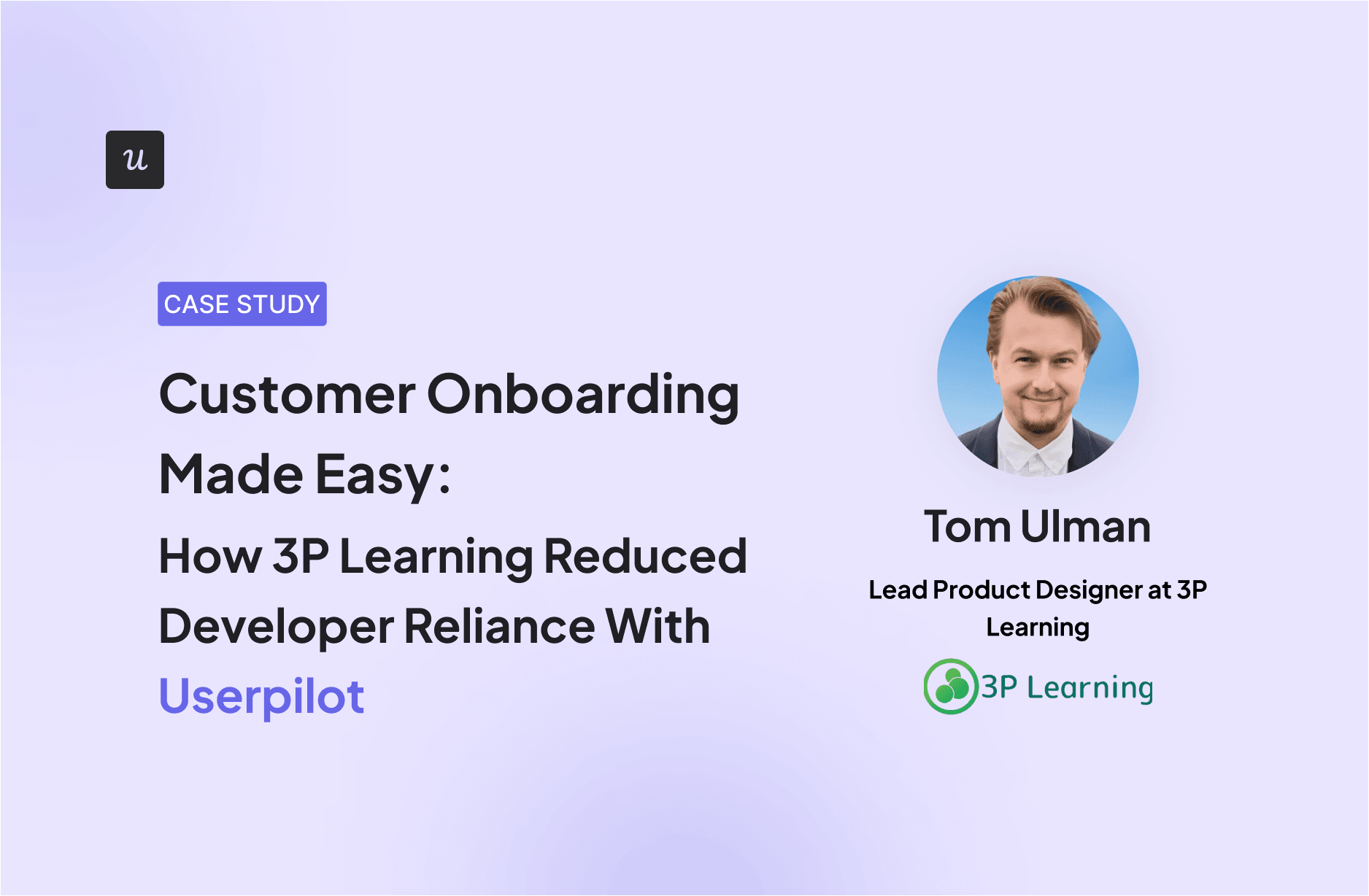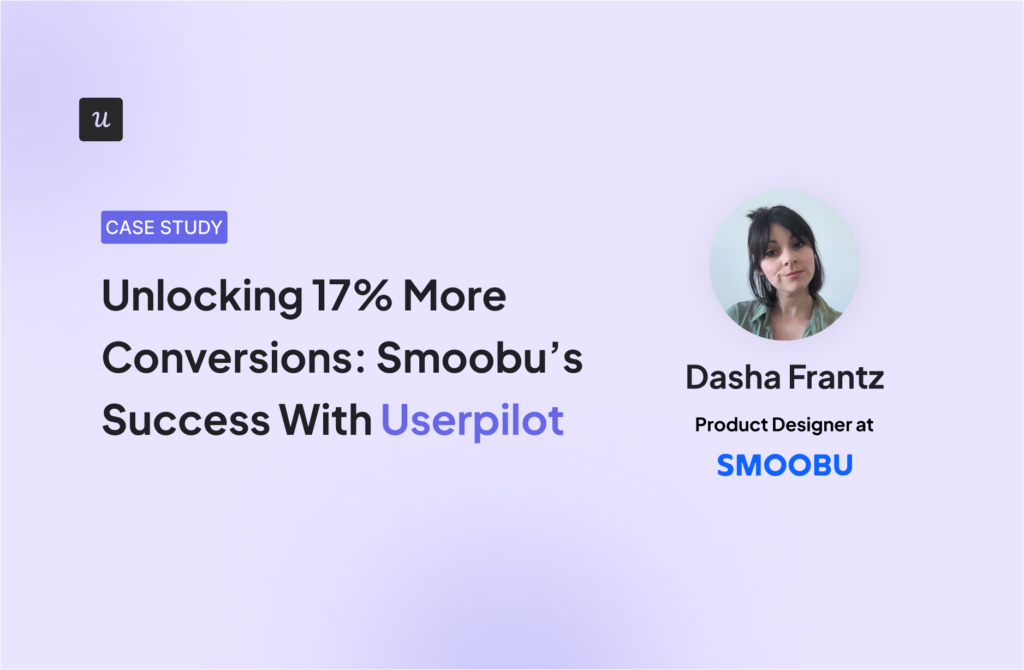
Customer Onboarding Made Easy: How 3P Learning Reduced Developer Reliance With Userpilot7 min read
3P Learning is an Australian educational technology company that specializes in developing online learning resources. Its products use gamified experiences that help young learners develop science, maths, and literacy skills.
We chatted with Tom Ulman, the Chief Product Designer at Reading Eggs, a 3P Learning company, about how they used Userpilot to improve the user onboarding experience.
Get The Insights!
The fastest way to learn about Product Growth, Management & Trends.
3P Learning’s success story – a quick summary
- Challenge: The marketing team at Reading Eggs relied on busy developers to build and adjust onboarding flows, which slowed down the process and lacked flexibility.
- Solution: The team chose Userpilot over UserGuiding due to its mobile optimization and comprehensive analytics, allowing them to create no-code onboarding experiences, analyze performance, and trigger targeted surveys without developer assistance.
- Results: Userpilot reduced the marketing team’s dependence on developers, streamlined operations, improved feature discovery, and allowed for quicker iteration based on user behavior and feedback – ultimately leading to more successful onboarding.
- Userpilot is a digital adoption platform with comprehensive functionality, including advanced analytics, feedback, and in-app engagement features. Book a demo to find out more!
Challenge: Relying on busy developers to build onboarding flows
Reading Eggs has two user personas: the learners and their parents.
The latter can manage their children’s learning experience by adjusting the level of learning and tracking their engagement and progress.
To master all these features, they need onboarding.
The problem was that non-tech teams couldn’t easily adjust the onboarding flows without the developer’s help. This process wasn’t very flexible, and all changes took time to implement.
They needed a more user-friendly solution.
Solution: Leveraging Userpilot for no-code onboarding
Before they chose Userpilot, 3P Learning considered UserGuiding as their onboarding platform.
However, UserGuiding wasn’t optimized for mobile web onboarding. Moreover, it offers very limited analytics.
How exactly do Reading Eggs use Userpilot?
Creating no-code onboarding experiences
The main application is creating onboarding checklists for the parents. They have also designed modal flows showing parents how to navigate the dashboard and feature announcements with Userpilot.
Thanks to Userpilot’s WYSIWYG editor, the marketing team can now create the themes and designs independently without the developer’s help.
Once ready, they can be reused by other team members. This simplifies the process and reduces everyone’s workload.
It’s been very easy for me to set up themes and designs that can then be reused by myself and others without having to require any development assistance.
– Tom Ulman, Lead Product Designer at 3P Learning
Analyzing the performance of onboarding flows
Tom’s team uses flow analytics to track the performance of the onboarding experience.
This feature allows them to see how users interact with the flows and identify issues that cause drop-offs. Flow analytics also allow them to compare different campaigns and modals to figure out the most optimal ways to engage different user segments.
We identify interactions with modals or campaigns. We’ve set goals to see click-through rates, and that’s allowed us to get a better overview of not only conversion but how people are interacting with the site before they view them and afterward, and also to identify areas of drop off during these flows.
– Tom Ulman, Lead Product Designer at 3P Learning
Triggering surveys to collect customer feedback and data
Userpilot analytics aren’t the only feature that helps Tom make better-informed decisions. The other one is in-app surveys.
Thanks to user segmentation and event-based triggering, they are able to target specific user groups and deliver the surveys at the most optimal moments.
For example, they use surveys to collect feedback on their placement tests and gauge user satisfaction. A custom event, which is the learner taking the test, triggers the survey. In this way, the experience is still fresh in their minds.
Within that survey, we’ll get a better understanding of why they’re taking the placement test, what’s prompted them to do that, and, get a review on their experience so we can enhance it.
– Tom Ulman, Lead Product Designer at 3P Learning
Results: Lesser dependence on developers and greater onboarding success
What positive changes has Userpilot implementation brought to 3P Learning?
First, it reduced the marketing team’s dependence on their developers.
The most powerful thing has been enabling marketers to be able to set up flows without dev assistance because we’ve got this growing bank of data that allows us to segment and change different rules.
– Tom Ulman, Lead Product Designer at 3P Learning
Being an all-in-one platform, it also streamlined their operations and allowed them to perform multiple tasks from one place.
From my usage and the way Userpilot’s been growing and changing, I see it as being very valuable to the company where we can have all these things combined, have the analytics, enable marketers to make changes on the fly with minimal dev assistance and hyper-personalize any marketing or user experience that we serve to customers.
– Tom Ulman, Lead Product Designer at 3P Learning
For example, they previously used Salesforce and MailChimp to deliver surveys (email only) and Hotjar to analyze user interactions inside the product. Now, they can do all of that and more with Userpilot.
The easy access to data allowed them to tighten the feedback loops. Iterating on user behavior and survey data is quicker if you can make changes and test them without developer assistance.
Userpilot has allowed us to have this workspace where we can keep iterating in the platform. Again, minimal dev assistance, and keep making fine-tune touches. So it’s kind of like a constant A/B test where we can change things.
– Tom Ulman, Lead Product Designer at 3P Learning
Finally, in-app feature announcements in Userpilot have improved new feature discovery, judging by the click-through rates and the feature usage data.
We had a new feature launch and used a Userpilot mobile modal to drive traffic. We had a really good response and click-through rate and had many people click through and explore that new feature.
– Tom Ulman, Lead Product Designer at 3P Learning
Userpilot – the best no-code onboarding software
Let’s go over Userpilot’s key features:
- The UI pattern library makes creating tooltips, modals, slideouts, and driven actions a breeze. You can trigger them individually or as a part of an interactive walkthrough when the user completes an event or at a specific time.

- Thanks to the analytics features, you can analyze the performance of onboarding experiences and use the insights to inform optimization decisions.

- As you’re tweaking your flows, you can A/B test them to identify the best-performing ones.

- Creating surveys is as easy as the onboarding flows. You get the same visual editor and the same triggering options, and there is a template library, too.

- To complement the onboarding experience, Userpilot offers a resource center. You can use it to provide self-service support materials, like tutorials or how-to guides

Conclusion
3P Learning needed a platform to onboard its users, collect customer feedback, and analyze user engagement with the product. Userpilot allowed them to achieve all their objectives with minimal dev assistance.
If you’d like to learn more about Userpilot and how it can help you make better-informed decisions and improve product adoption, book a demo!




![How to Build No-Code User Onboarding [+ Top No-Code Tools] cover](https://blog-static.userpilot.com/blog/wp-content/uploads/2023/02/how-to-build-no-code-user-onboarding_7b32ae34722235767c03830839b7e320_2000-1024x670.jpg)



